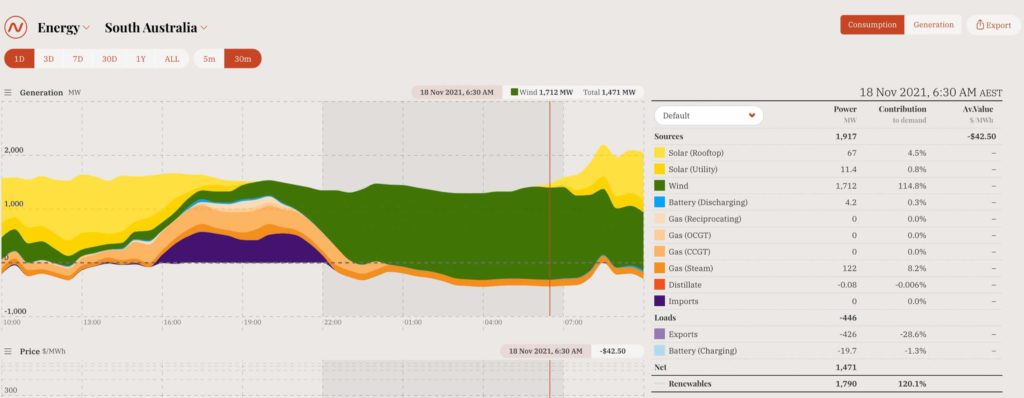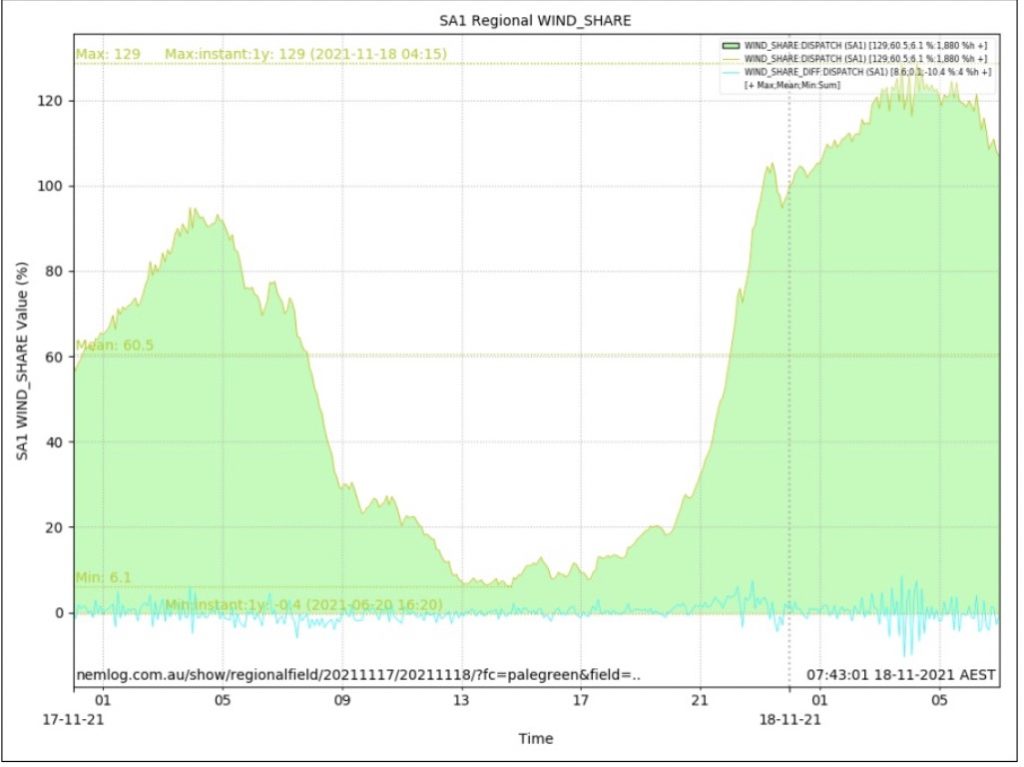The rapid transition of the South Australia grid towards a world-first target of net 100 per cent wind and solar has taken another stunning leap forward, with the amount of gas generation slashed by half, allowing wind energy to set a new record of its own.
South Australia regularly reaches levels of more than 100 per cent wind and solar – in fact it has done that for all but three days since the start of October.
But often the amount of wind and solar that is generated has to be constrained to ensure that a certain amount of gas generation can supply “system strength” and keep the grid stable. The excess capacity is usually exported to Victoria, although small amounts are also stored in the state’s three big batteries.
However, four new machines known as “synchronous condensers” that deliver the same system strength as fossil fuel generators, without actually burning any fossil fuels, have now completed their testing, and on Thursday for the first time market authorities appeared to dial back the minimum amount of gas by half.
Market observers say that at least 220MW of gas generation has been required to keep the system stable till now, but on Thursday it was dialled back to just 120MW. In turn, this allowed wind output to be increased to a record 128.6 per cent share of local demand at 4.15am.

Geoff Eldridge, who runs a data resource known as NEMLog, observed that the Australian Energy Market Operator and other bodies are now happy to run with a record low total of 120MW for South Australia gas. In this instance, it was three units at Torrens Island B, and the biggest generator, Pelican Point, switched off.
“Previously it has been around 220 to 250MW,” Eldridge says. “There is lots of SA wind at the moment, the syncons are now contributing to providing system security to SA during periods of high VRE (variable renewable energy, or wind and solar) share.”
In the immediate term that meant that there was another 100MW to 130MW of wind and/or solar that was not curtailed by the limits of the local grid and the main link to Victoria. Earlier this week, nearly half of the wind and solar produced by large scale facilities had to be curtailed.
But the bigger picture is more exciting. It shows that South Australia is edging closer – not just to an average of “net 100 per cent” wind and solar by 2030 (the state Liberal government target which it will likely be met much earlier),but also running the grid at times with no fossil fuels at all.
That has been done on occasions in smaller off-grid locations, and on bigger grids with substantial resources of hydro or geothermal, but never at a gigawatt scale grid with just wind and solar.

As ITK principal and Energy Insiders podcast co-host David Leitch observed on the latest episode, big batteries are demonstrating their ability to act as “virtual synchronous machines” and will likely take the place of either syncons, or gas generators, or both, in providing the necessary grid security.
This already occurs on remote networks such as in the Pilbara, where Alinta’s Mt Newman battery has removed the need for running gas generators as back up, lowering costs and emissions and improving reliability, and has on occasions provided all the synchronous capacity required.
That battery – sized at just 35MW/12MWh – is designed to do this for only short bursts. Sometime in the next few years, however, that could occur in the South Australia grid.
Big batteries on Australia’s main grid have been providing similar services.
And this cool video from Tesla (whose batteries are used in the Hornsdale, Gannawarra, and Bulgana batteries, along with the Victoria Big Battery and Wallgrove batteries now being commissioned) illustrates how this happens.
It says that software-controlled batteries are a viable alternative to traditional synchronous machines to provide the reliability and security services needed for an affordable, flexible and zero emissions electricity grid.
And getting rid of fossil fuels altogether – even for a short period of time – and relying only on wind, solar and batteries and/or syncons would be a truly stunning landmark towards a zero emissions grid.
That ground-breaking achievement is likely to happen anyway, when the new Project EnergyConnect transmission link is completed by early 2025, and will end the need for directions for a minimum amount of gas generators to operate in most circumstances.
As another energy expert observed in a Facebook group: “Finally we are seeing real progress in SA with the lowest level of standing fossil I have seen in a long time.
“This is largely due to the partial recognition of the sync cons and batteries in the SA grid. With luck we should see this figure drop to 80MW. Then after AEMO issues new rules, this should drop further.
“There should actually be enough support in the SA grid now to cease all fossil gas generation for reasons of grid stability.”
Another simply said: “What a beautiful set of numbers?”
See also:
Video: Tesla shows how batteries can kick fossil fuels out of the grid
Cheaper, cleaner, more reliable: The stunning success of South Australia’s renewable transition
South Australia curtailed nearly as much wind and solar on Sunday as it used
One pumped hydro project still standing as South Australia heads to 100pct wind and solar










